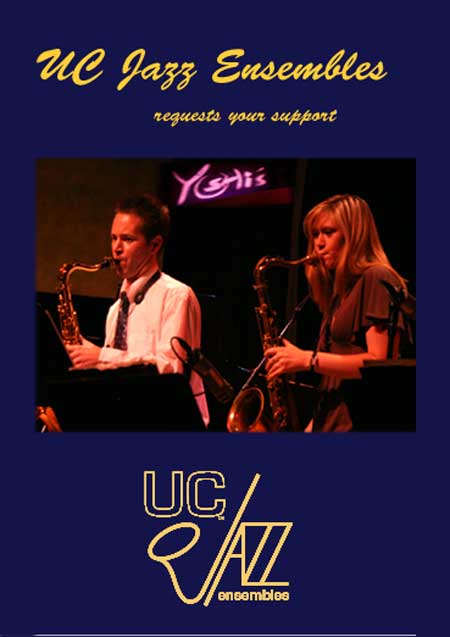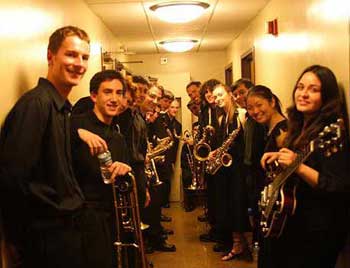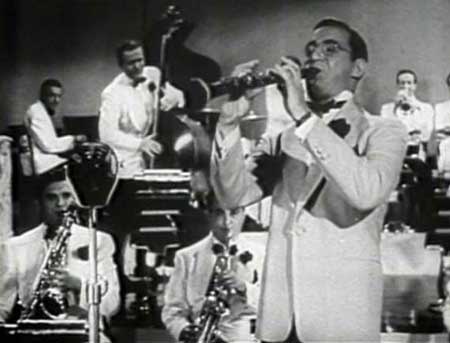by Ranie Smith, Executive Director of the UC Jazz Club
“The UC Jazz Club wishes to thank all its members and the community at large for your continued support. “

“An Evening at Yoshi’s “
On November 12, 2007 the UC Jazz Ensembles performed their First Annual Fundraising Concert. The performance was stellar. Ted Moore, the Musical Director, Brad Brennan, Associate Director of Student Musical Activities together the Carol Suveda, Head of the Fundraising committee were pleased with the community response. It was clear that the community was greatly pleased with the students performance.
The fundraiser could not have been as successful without the strong support of Linda Marquardt, mother of Megan Marquardt. Megan dazzled audiences with her stellar performance. Members of the audience who had not experienced a UC Jazz Ensembles show expressed their astonishment. They applauded the performances, the flawless timing and the amazing solo performances, and the creative interplay between the instruments.
Enjoy the performance! Eddie Lankford Productions filmed a large part of it for your enjoyment. We hope that you will agree with the UC Jazz Club members that this is a worthwhile music program that provides these committed and talented students a chance to deepen their talent. Your continued support is much appreciated.
Frank Martin’s Advanced Combo brought a performance worthy of the beautiful and renown venue at Yoshi’s. Megan Marquardt, tenor sax, and Rolf Olson, tenor sax, gave a stunning performance together with Jeff Wiguna. Ryan Finch, bass, and Alex Wheatley, drums and Luke Hardesty, drums grounded the performance with their flawless rhythm section. They opened up with “Steps” by Chick Corea, brought the house down with “Sonnymoon for Two” by Sonny Rollins. Rosette Diaz, special guest vocalist, stole the show with her spirited and ravishing performance of “Straighten Up and Fly Right”. Megan Marquardt and Rolf Olson amazed the audience with their rendition of “Nardis” by Miles Davis, and Jeff Wiguna, held the audience spell-bound with his performance of “Armando’s Rumba” by Chick Corea.
Ted Moore’s Advanced Combo gave a performance that gave you the feeling of being in the presence of greatness. Amy Shen shined on both the flute and the alto saxophone. She was complimented and supported by Andrew Baltazar on tenor sax, whose performance was flawless and mature giving you the feeling of listening to a much older jazz great. Richard Conway, trumpet, amazed as always with his precision and technique. Kirk Danielson, an award-winning pianist, carried off a performance that silenced the room with the audience spell-bound. Gary Johnson, bass, captured the audience and left them hungry for more. We hope he will keep playing because we want to hear him any chance we can get. He is hugely talented. Yanik Jayaram, drums, has a light touch that gave this ensemble a light-hearted backdrop. They performed Invitation by Kaper/Washington, Tuties, by Gary Johnson – we will keep watching his career. Please Gary keep playing! The classic of “Love for Sale” by Cole Porter was followed by the Killer June by Ted Moore and Rubidium, by Amy Shen. This ensemble touched the soul and left you wishing for more.
The second set began with Dann Zinn’s Advanced Combo who showed Amy Shen and Andrew Baltazar on woodwinds. Amy is so amazing! She composes and is stellar on every instrument she plays. Charles Chen gave a piano performance that was passionate and showed off his technique. Clayton Ernst and the superbly talented Benny Amon played with a majority beyond their age in supporting the band. The entire ensemble played in a way that gave the impression that these complex pieces were easy for them to play. They performed “Free for All” by Wayne Shorter, “Mei Hua” by Amy Shen, “Solace in a Dream” by Amy Shen, and “Eat the Piano” by Charles Chen.
The show ended with a stellar Big Band performance, which we unfortunately could not film this time around. They were amazing and we encourage you to read the UC Jazz Newsletter regularly to make sure you can catch them next time. Steve Campos organizes regular performances with his Big Band and we encourage you to check out his impressive background. His experience is transmitted to the Big Band who play together as though have have been together for years.
Please join the UC Jazz Club and join in the fun. Our club members learned quickly that the joy we get out of supporting this wonderful program greatly outweighs the effort we put into supporting them. Join in the fun of keeping this all important cultural program alive. Come to the performances or give a secure online donation using your credit card at: https://egiving.berkeley.edu/urelgift/jazz.html
We appreciate your support! And, we hope you enjoy this and future shows!
Warm Regards,
Ranie Smith
Executive Director, UC Jazz Club
We have much to appreciate this year!
Enjoy the photo library














